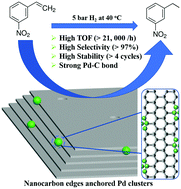Hollow carbon anchored highly dispersed Pd species for selective hydrogenation of 3-nitrostyrene: metal-carbon interaction†
Abstract
Constructing Pd–C bond between Pd particles and defective hollow nanocarbons (h-NCs) not only enables facile H2 dissociation but also diffusion of the dissociated H species, which makes the Pd/h-NC highly active with a TOF of 21 845 h−1 (>80 times higher than that of the best catalyst in literature), selective (97%), and stable (4 cycles) for selective hydrogenation of 3-nitrostyrene to 3-ethylnitrobenze.



 Please wait while we load your content...
Please wait while we load your content...
